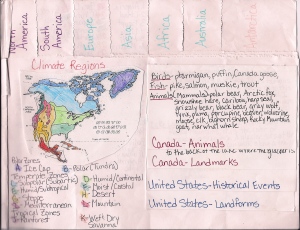Foldables® – Social Studies Continent Book
I have an old, new favorite. Foldables. I was exposed to them several years ago by a science teacher and used them in my Newcomer Social Studies class when I couldn’t find appropriate materials. I was working on the 7 continents, the countries within those continents, and pulling facts from text. I pulled maps from the Geography Coloring Book which was great because they were small enough to fit into my book. I then assembled a foldable that allowed each continent to have its own two page spread.
Each continent had three sets of information: country names, climate zones, and facts about two countries in that continent. They were able to choose the type of information that they found on their countries. They could choose: animals, landmarks, culture, landforms, or historical events. I checked nonfiction texts out from the library to help them find the information. We used an atlas to find the names of the countries.
By the end of this project, my newcomers were able to search for specific information from nonfiction text, pull that information from text, and use it in their book. As a culminating activity, I had them answer questions using the book as their resource. I was looking to see if they could pull specific information from their own book.
This activity was engaging, interactive, and students were able to work at their own pace. A success all around!
Since then, I have discovered that Dinah Zike has created many books on the different types of foldables that you can use in classrooms. Pictured below are some other social studies examples from her. I purchased one of her books and am looking forward to incorporating these strategies into my classes.
I will also be talking about math, science, and language arts foldables that I have created and used in my classrooms.





